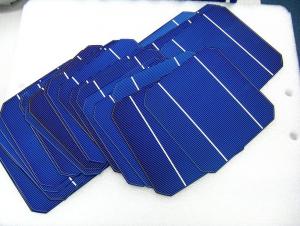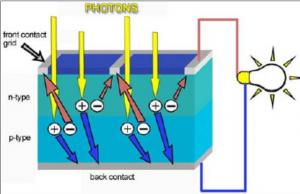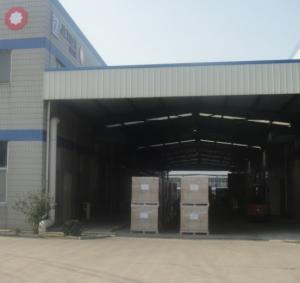Mono Solar Cell 125mm 125 mm 125 mm 0.5 mm
- Loading Port:
- China main port
- Payment Terms:
- TT or LC
- Min Order Qty:
- 40000 watt
- Supply Capability:
- 100000 watt/month
OKorder Service Pledge
OKorder Financial Service
You Might Also Like
Details Of Mono Solar Cell 125mm
Specifications Of Mono Solar Cell 125mm
1.Mechanical data and design
Format | 125 mm × 125 mm ± 0.5 mm |
Thickness | 210 μm ± 40 μm |
Front(-) | 1.6 mm bus bars (silver),blue anti-reflection coating (silicon nitride) |
Back (+) | 2.5 mm wide soldering pads (silver) back surface field (aluminium) |
2.Temperature Coefficient of Cells
Voc. Temp . coef.%/K | -0.35%/K |
Isc . Temp . coef.%/K | +0.024%/K |
Pm. Temp. coef.%/K | -0.47%/K |
3.Electrical Characteristic
Efficiency(%) | Pmpp (W) | Umpp (V) | Impp (A) | Uoc (V) | Isc (A) | FF (%) |
18.35 | 2.841 | 0.532 | 5.342 | 0.631 | 5.67 | 79.41% |
18.20 | 2.817 | 0.53 | 5.319 | 0.631 | 5.64 | 79.16% |
18.05 | 2.794 | 0.527 | 5.301 | 0.63 | 5.63 | 78.77% |
17.90 | 2.771 | 0.527 | 5.259 | 0.629 | 5.62 | 78.39% |
17.75 | 2.748 | 0.526 | 5.224 | 0.629 | 5.61 | 77.88% |
17.60 | 2.725 | 0.524 | 5.201 | 0.629 | 5.59 | 77.50% |
17.45 | 2.702 | 0.52 | 5.196 | 0.629 | 5.586 | 76.90% |
17.30 | 2.678 | 0.516 | 5.183 | 0.626 | 5.577 | 76.71% |
17.15 | 2.655 | 0.513 | 5.175 | 0.623 | 5.565 | 76.58% |
17.00 | 2.632 | 0.51 | 5.161 | 0.622 | 5.559 | 76.12% |
16.75 | 2.593 | 0.508 | 5.103 | 0.615 | 5.477 | 76.98% |
16.50 | 2.555 | 0.506 | 5.047 | 0.608 | 5.396 | 77.88% |
4.Intensity Dependence
Advantage Of Mono Solar Cell 125mm
1: high quality cell, Level A cell (16.50%—18.35%)
2: Dimensione:125*125mm Diagonal:150mm / 165mm
Dimensione:156*156mm Diagonal:200mm
3: Qualified certification: TUV,CE certification.
4: Warranty: five years for whole unit
Usage/Application Of Mono Solar Cell 125mm
Packaging & Delivery Of Mono Solar Cell 125mm | |
Packaging Detai | Packaging Detail:Export Carton and Pallet or under customer request. |
Delivery Detail:10-20days | |
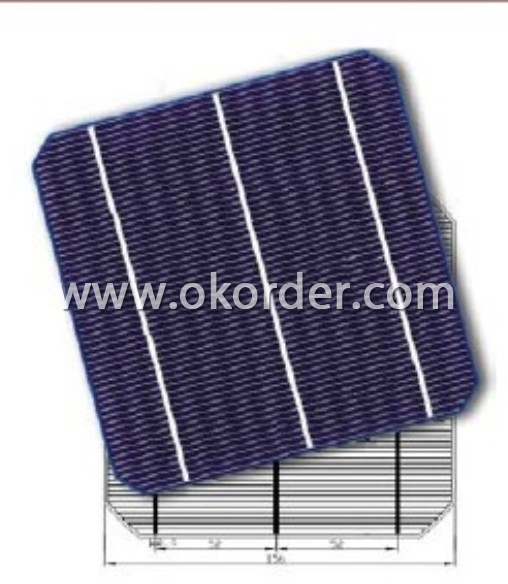
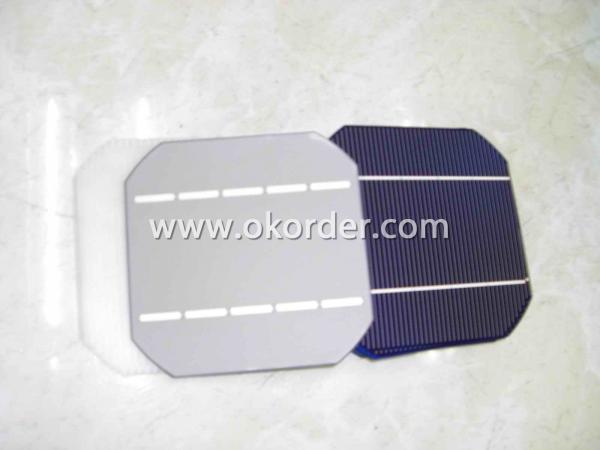
Converting the sun’s radiation directly into electricity is done by solar cells. These cells are made of semiconducting materials similar to those used in computer chips. When sunlight is absorbed by these materials, the solar energy knocks electrons loose from their atoms, allowing the electrons to flow through the material to produce electricity. This process of converting light (photons) to electricity (voltage) is called the photovoltaic effect.
When photons are absorbed by matter in the solar cell, their energy excites electrons higher energy states where the electrons can move more freely. The perhaps most well-known example of this is the photoelectric effect, where photons give electrons in a metal enough energy to escape the surface. In an ordinary material, if the electrons are not given enough energy to escape, they would soon relax back to their ground states. In a solar cell however, the way it is put together prevents this from happening. The electrons are instead forced to one side of the solar cell, where the build-up of negative charge makes a current flow through an external circuit. The current ends up at the other side (or terminal) of the solar cell, where the electrons once again enter the ground state, as they have lost energy in the external circuit.
Solar cells, which were originally developed for space applications in the 1950s, are used in consumer products (such as calculators or watches), mounted on roofs of houses or assembled into large power stations. Today, the majority of photovoltaic modules are used for grid-connected power generation, but a smaller market for off-grid power is growing for remote areas and developing countries.
Given the enormous potential of solar energy, photovoltaics may well become a major source of clean electricity in the future. However, for this to happen, the electricity generation costs for PV systems need to be reduced and the efficiency of converting sunlight into electricity needs to increase. To achieve this, the Commission supports photovoltaics development since many years by funding research projects and facilitating cooperation between stakeholders.
- Q:Can solar cells be used in space heating systems?
- Yes, solar cells can be used in space heating systems. Solar cells can convert sunlight into electricity, which can then be used to power heating systems. This can be done through the use of solar thermal collectors or by converting the electricity generated by the solar cells into heat using electric heaters.
- Q:Can solar cells be used in marine applications?
- Yes, solar cells can be used in marine applications. They can be installed on boats, ships, or other marine vessels to generate electricity from the sun. These solar cells can power various onboard systems and equipment, reducing the dependency on traditional fuel sources and providing a sustainable energy solution for marine applications.
- Q:Can solar cells be used to power electronic devices?
- Yes, solar cells can be used to power electronic devices. Solar cells convert sunlight into electricity, which can then be used to power a wide range of electronic devices such as smartphones, laptops, calculators, and even larger appliances like refrigerators or streetlights. This allows for a sustainable and renewable source of energy for various applications.
- Q:What is the impact of wind on solar cell performance?
- The impact of wind on solar cell performance can be both positive and negative. On one hand, wind can help to cool down the solar panels, preventing them from overheating and maintaining their efficiency. Additionally, a gentle breeze can help to disperse any accumulated dust or debris on the panels, ensuring maximum sunlight absorption. On the other hand, strong winds can create vibrations that may damage the solar panels or the mounting structure, leading to potential performance degradation or even system failure. Therefore, while some wind can be beneficial, it is important to properly design and install solar panels to withstand and minimize any negative impact from strong winds.
- Q:What is the effect of shading on solar cell performance?
- Shading has a significant negative effect on solar cell performance as it reduces the amount of sunlight reaching the cell, leading to decreased energy production. Even a small shaded area can cause a significant drop in efficiency, as solar cells are interconnected and operate in series. The shaded portion acts as a barrier, limiting the flow of current and reducing overall power output. Therefore, it is crucial to minimize shading to maximize the performance and efficiency of solar cells.
- Q:Can solar cells be used to power electric fences?
- Yes, solar cells can be used to power electric fences. Solar panels can convert sunlight into electricity and store it in batteries, which can then be used to power the electric fence. This allows for a sustainable and reliable power source for electric fences, especially in remote locations where connecting to the grid may not be feasible.
- Q:How can solar cells be used in residential applications?
- Solar cells can be used in residential applications by installing solar panels on rooftops or other open areas to capture sunlight and convert it into electricity. This clean and renewable energy source can power various appliances and lighting systems within a home, reducing reliance on traditional grid electricity and lowering utility bills. Additionally, excess energy generated by solar cells can be stored in batteries or fed back into the grid, further promoting sustainability and potentially earning homeowners credits or incentives.
- Q:Can solar cells be used in space stations?
- Yes, solar cells can be used in space stations. In fact, they are commonly used to provide power to space stations by converting sunlight into electricity.
- Q:What are the tin bands, sinks and interconnections used on solar modules, and what are the solar cells used in the solar cells?
- At present, the general crystal silicon cells using p-type silicon, in the phosphorus diffusion process, the two sides of the silicon and the edge will be phosphorus doping.
- Q:Is the Photovoltaic Cells cheap to buy?
- Cost Of Photovoltaic Cell has dropped an amazing 99% since 1977, which is a historical statistic we can tell from the past 30 years. So I think the answer should be yes.
1. Manufacturer Overview |
|
|---|---|
| Location | SanShui City, Guang Dong, China. |
| Year Established | 2009 |
| Annual Output Value | Above 10 billion RMB |
| Main Markets | Mid East;Western Europe;North America;Southeast Asia |
| Company Certifications | TUV ISO9001;SGS |
2. Manufacturer Certificates |
|
|---|---|
| a) Certification Name | |
| Range | |
| Reference | |
| Validity Period | |
3. Manufacturer Capability |
|
|---|---|
| a)Trade Capacity | |
| Nearest Port | Zhuhai, Foshan |
| Export Percentage | 0.4 |
| No.of Employees in Trade Department | about 600 |
| Language Spoken: | English;Chinese; |
| b)Factory Information | |
| Factory Size: | 66666.7m2 |
| No. of Production Lines | 12 |
| Contract Manufacturing | OEM Service Offered;Design Service Offered |
| Product Price Range | USD 0.3-0.45/Wp |
Send your message to us
Mono Solar Cell 125mm 125 mm 125 mm 0.5 mm
- Loading Port:
- China main port
- Payment Terms:
- TT or LC
- Min Order Qty:
- 40000 watt
- Supply Capability:
- 100000 watt/month
OKorder Service Pledge
OKorder Financial Service
Similar products
New products
Hot products
Related keywords
